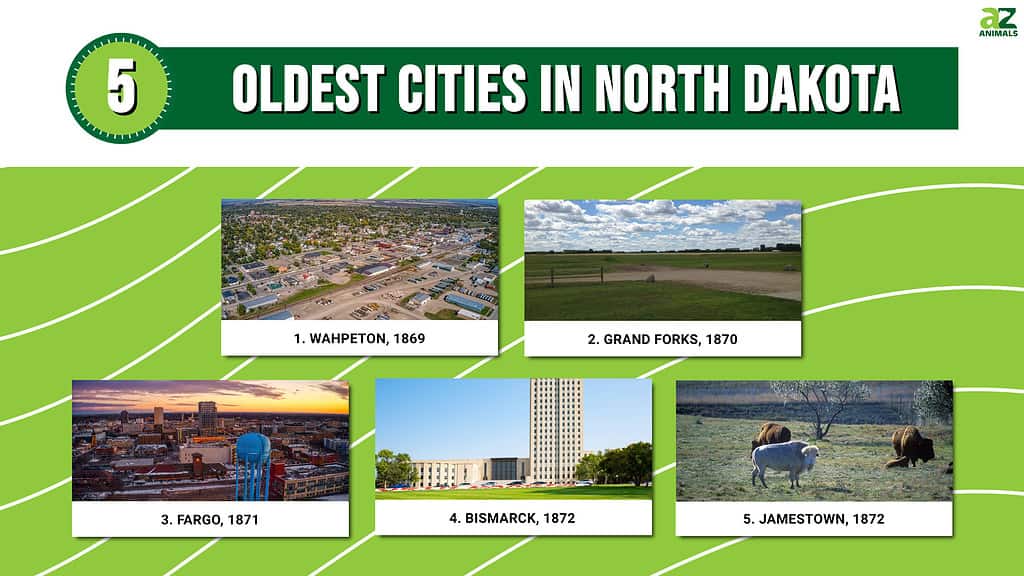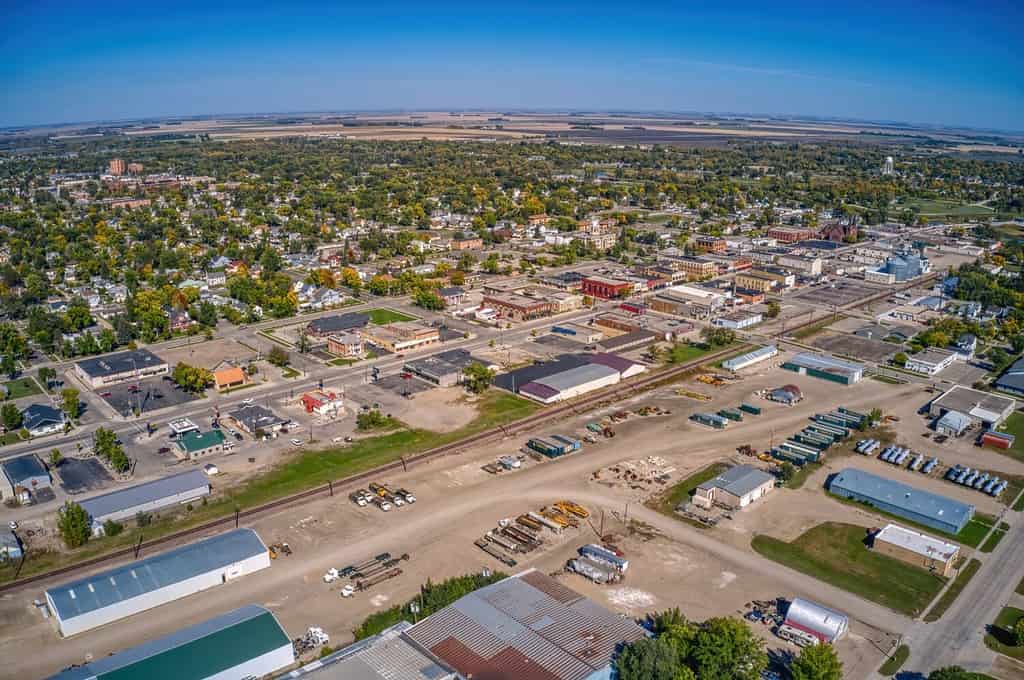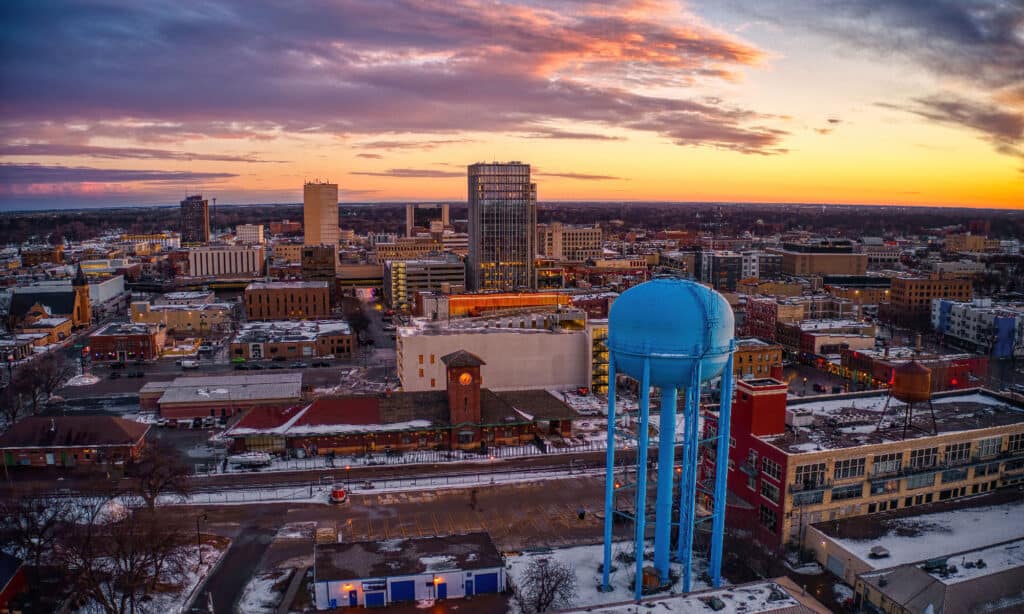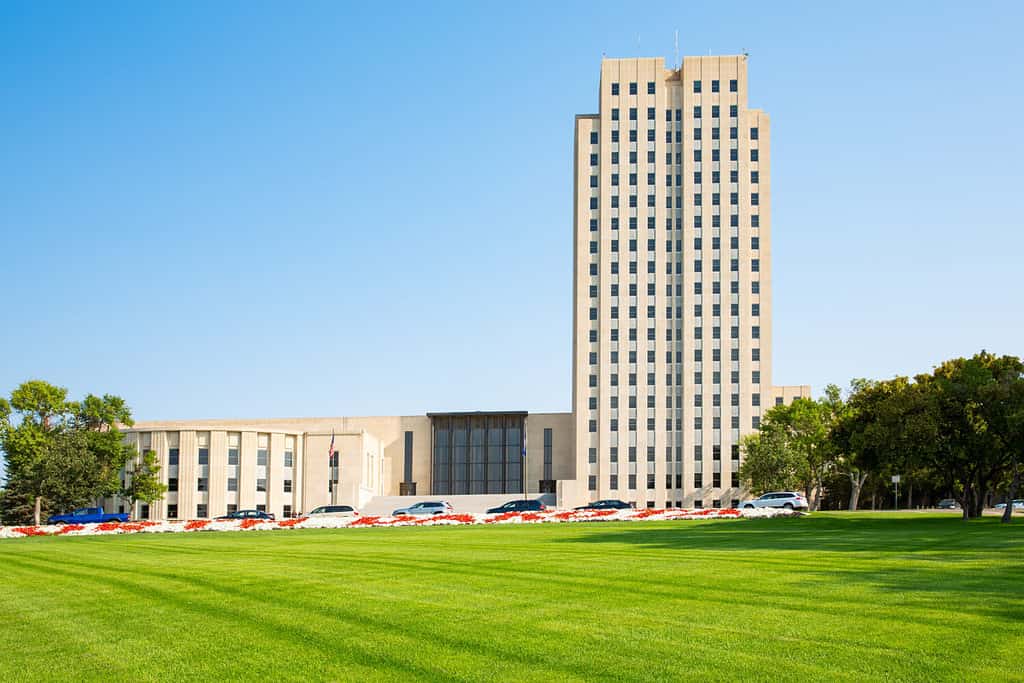With a population of only 775,000, North Dakota is one of the most unspoiled states in the United States. It’s known for farming, mining, and petroleum products and wide-open, big-sky plains. But it’s also a state of friendly small cities with interesting histories and all the amenities you need, whether you’re just passing through or planning to make this peaceful, out-of-the-way place your home. Join us in a discovery of 5 of the oldest cities in North Dakota, and maybe plan to visit some of them on your next road trip.

1. Wahpeton, 1869 (population 8,007)
History of Wahpeton
Wahpeton is located in southeast North Dakota near the border of Minnesota. It attracted settlers because of its location in a fertile river valley where the Otter Tail River and the Bois de Sioux River intersect with the Red River of the North. The city name means “leaf dwellers” in the local Dakota language. Wahpeton became a trading hub with the use of flatboats to bring goods from as far north as Winnipeg, Manitoba. But as with many Western towns, it was a connection to the railroad system that ensured the community would survive while others faded away. Unfortunately, the town was part of the now-discredited practice of setting up Indian boarding schools that took Native American children from their parents and forced them to assimilate into white culture and the Christian religion. In 1970, the school was turned over to an inter-tribal group and renamed “Circle of Nations School.”
What to Do in Wahpeton
Travelers to Wahpeton will know they’ve arrived when they see a 40-ft long fiberglass sculpture of a catfish beside the Red River of the North. Wahpeton is popular with hunters as it is on the migratory route of several bird species. Golfers might enjoy the experience of the only course that runs into two states: the Bois de Sioux Golf Course with a footprint in both North Dakota and Minnesota. Bagg Bonanza Farm is a historic 15-acre farm with restored buildings, a country store, and local products and souvenirs. Chahinkapa Zoo is a small zoo with a variety of crowd-pleasing exotic animals: tigers, eagles, gibbons, rhinos, lemurs, kangaroos, orangutans, and gibbons. There’s also a 1926 restored carousel. Red Door Art Gallery and Visitor Center is where you can enjoy and support the work of local artists.

Wahpeton, North Dakota enjoyed a favorable location on rivers and a railroad that made it a trading center for the region in the days before highways.
©Jacob Boomsma/Shutterstock.com
2. Grand Forks, 1870 (population 59,166)
History of Grand Forks
Grand Forks sits on the western bank of the Red River of the North in the Red River Valley. In frontier days it was a popular place for French trappers and Native Americans to meet and trade for furs. The U.S. claimed it as part of the Louisiana Purchase of 1803, but ownership wasn’t clearly established until boundary disputes with Great Britain settled the border with Canada in 1818. Because a large Native American population lived in the area of Grand Forks, it wasn’t settled by European Americans until the late 1800s. In 1883 the University of North Dakota was established there as the first university in the state. Since the 1950’s a U.S. Air Force base has been located nearby. Today UND is especially celebrated for its School of Aerospace Sciences, including its Air Traffic Control Training Program.
What to Do in Grand Forks
College sports, especially ice hockey, and football, are popular in Grand Forks, which has two athletic arenas. The city has a large number of recreation areas: 14 parks, 28 tennis courts, 2 swimming pools, 3 splash parks, fields for baseball, softball, and soccer, tennis and basketball courts, picnic areas, and playgrounds. The parks also have outdoor skating rinks and ski trails, as winter sports are popular in this northern state. There are also easy, level trails to walk along the Red River and see wildflowers in season. Turtle River State Park 30 minutes away has fantastic fishing and camping and is a good place to enjoy nature every season of the year. Grand Forks has a large number of restaurants, including some specializing in regional food, which is always a plus when visiting new places.

A beautiful, natural summer landscape near Grand Forks. In North Dakota, the sky can feel surreally large and close.
©iStock.com/PictureItPerfect
3. Fargo, 1871 (population 125,990)
History of Fargo
Fargo is North Dakota’s largest city by population, with almost 126,000 people. Nearly one out of every 7 people in the state live there. It’s at approximately the midpoint between Wahpeton and Grand Forks. Like them, it is part of the fertile river valley of the Red River of the North. Fargo was a steamboat stop in Dakota Sioux territory in the late 1800s, giving it an advantage over other cities in trade and as a supply point for settlers and soldiers. It was named after the founder of the Wells Fargo company, William Fargo. A dubious distinction of Fargo was that it became known as the “divorce capital of the Midwest” because of its lenient divorce laws. The city was devastated by an F5 tornado after World War II, but after extensive analysis of that tragedy, meteorologist Ted Fujita devised the Fujita scale of tornado intensity that is still used today and developed models that help scientists make predictions about the behavior of tornadoes.

North Dakota is part of “Tornado Alley.” After much of Fargo was destroyed by a massive tornado, the famous Fujita Scale was developed and was used to rank the Fargo tornado as an F5.
©Huntstyle/Shutterstock.com
What to Do in Fargo
Fargo has an exceptional number of museums that are frequented by visitors. The Roger Maris Museum commemorates the life and career of a famous major league baseball player. The Fargo Air Museum has an outstanding display of historic aircraft, almost all of which are still in flying condition. There’s even an early Wright Brothers aircraft. The museum offers a Young Aviator camp for children. Definitely include Bonanzaville in your travel plans. It’s a history museum with 47 restored historic buildings, including a general store, jail, schoolhouse, and church to let you experience what life on the frontier was like. Special sections of the museum focus on things like law enforcement and the history of the telephone. Red River Zoo will be of interest if you’d like to learn more about local wildlife, as well as exotic animals from around the world. Finally, the Fargo Marathon is a major event for all ages, with rock bands and DJs lining the route, thousands of spectators, and lots of fun associated events. This race is a qualifier for the Boston Marathon.

Wintertime in Fargo, one of the oldest cities in North Dakota.
©Jacob Boomsma/Shutterstock.com
4. Bismarck, 1872 (population 73,622)
History of Bismark
Bismarck has been the state capital of North Dakota since statehood was achieved in 1889. It is the second-largest city after Fargo. The local Mandan tribe called it the “place of the tall willows.” The European-American settlement got started in 1872 at the place where the Lewis and Clark Expedition crossed the Missouri River. It was named after German Chancellor Otto von Bismarck in hopes of attracting more German investment and colonists to the area. The city was founded at an advantageous moment because just two years later gold was discovered in the Black Hills of neighboring South Dakota. Bismarck became an outfitting station for prospectors buying supplies and leaving to stake their claims in the gold fields. However, this also put Bismarck in the epicenter of the Great Sioux War that erupted in 1876. During World War II, over 4,000 German and Japanese POWs were interred in a camp in Bismarck, the largest such facility in the United States. Over time, Bismarck developed a diversified economy in agriculture, farm equipment manufacturing, oil, gas, and coal production and distribution, education, and health care.
What to Do in Bismarck
Here are a few of the interesting things there are to do in Bismarck:
- Take your photo with the World’s Largest Sandhill Crane. “Sandy” is a 4.5-ton replica of a species of bird that migrates through North Dakota annually.
- Visit the Dakota Zoo. It has 90 acres of forest and over 125 species represented, including some that are endangered.
- Tour the historic former Governor’s Mansion, built in 1884, the home of 20 state governors (but not all at once). The garden has 60 species of heritage plants and exhibits.
- Check out a full-scale replica of the boat used by Lewis and Clark at Keelboat Park.
- Take a dinner cruise on the Lewis and Clark Riverboat. It seats 150 and offers dining, entertainment, and a bar daily from May-September.

The state capitol building, in Bismark, North Dakota.
©Traveller70/Shutterstock.com
5. Jamestown, 1872 (population 15,849)
History of Jamestown
Jamestown was named after the first permanent English settlement in the New World, Jamestown, Virginia. It was established by the Northern Pacific Railroad when they were building a bridge over the local James River. The U.S. Army established Fort Seward in the area and stationed 120 soldiers there, which added to the population and made the area more secure for settlers. Over time, the economy developed with railroad repair services, trucking and heavy equipment businesses, agriculture, food processing, and retail companies. But no doubt the city’s greatest claim to fame is as the birthplace of the American writer Louis L’Amour, author of over 100 formula Western books that were popular because of their detailed portrayals of frontier life. His novels, including How the West Was Won, sold over 200 million copies, and 30 of them were made into movies.

Acclaimed author Louis L’Amour lived in Jamestown. His books and the films made from them shaped generations of Americans’ ideas about the rough and lawless American frontier.
©Bob Pool/Shutterstock.com
What to Do in Jamestown
Like several other cities in North Dakota, Jamestown has its own giant road art: “The World’s Largest Buffalo,” a 26-ft-tall behemoth named “Dakota Thunder.” While you’re at it, visit the National Buffalo Museum to learn about the history, cultural significance, and cultural impact of bison, and see a living herd of them on the museum property. If you want to know what they taste like, you can eat a bison burger or steak at Sabir’s Buffalo Grill. Jamestown has its own Frontier Village with original restored buildings and period antiques and artifacts to learn about the lives of early settlers and Native Americans. They have a writer’s shack dedicated to Louis L’Amour. The Fort Seward Wagon Train will give you a memorable experience, riding in a caravan of covered wagons and eating meals around a campfire. Finally, the city has three 12-mile-long reservoirs with lots of opportunities for fishing and various water sports.

Bison, including a rare white one, at the National Buffalo Museum in Jamestown, North Dakota.
©Joseph Sohm/Shutterstock.com
A Last Frontier of the Plains
If you want to experience what is left of the Old West and America’s remaining wilderness lands, you can certainly head out to the Rockies, the deserts of the Southwest, or even Alaska. But what North Dakota has to offer is the closest you’ll get to seeing the Great Plains without overcrowded cities and clogged highways. North Dakota offers not just static museums with things you can see behind glass, but frontier houses you can walk through, animals you can touch, smell (and taste), and covered wagons you can ride. Once you visit the countryside and the oldest cities in North Dakota, you’ll wonder why so few people have discovered it. And maybe you won’t want to tell anyone about it, to keep it that way.
Summary of 5 of the Oldest Cities in North Dakota
| Rank | City | Date Founded/Established |
|---|---|---|
| 1 | Wahpeton | 1869 |
| 2 | Grand Forks | 1870 |
| 3 | Fargo | 1871 |
| 4 | Bismarck | 1872 |
| 5 | Jamestown | 1872 |
The photo featured at the top of this post is © ZakZeinert/Shutterstock.com
Thank you for reading! Have some feedback for us? Contact the AZ Animals editorial team.






